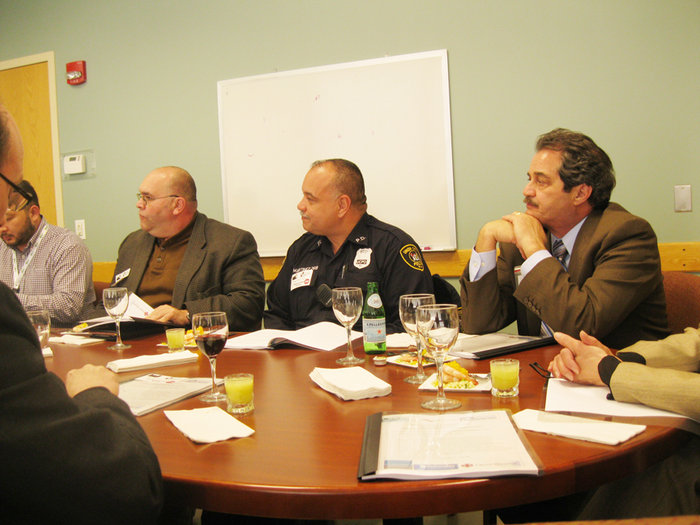Still licking their wounds from the worst hurricane to hit the region in the last century, local hospitals organized what will likely become the first of a series of meetings to plan out a strategy not just for dealing with new storms, but also potential terrorist attacks.
The idea is to pool resources and evaluate needs so that hospitals can help each other and work with local emergency management teams.
On Thursday, April 4, representatives from Meadowlands Hospital, Bayonne Medical Center, Liberty Health Care, Hoboken University Medical Center, Palisades Medical Center, and Christ Hospital were invited to meet at Meadowlands Hospital in Secaucus with public officials including Secaucus Mayor Michael Gonnelli and emergency management officials to form a Hudson County Disaster Planning Work Group.
The purpose was to standardize local hospitals’ disaster plans in the wake of Hurricane Sandy.
Among those who attended were Sara Vieira, RN, patient care director for Christ Hospital Emergency Department; Police Detective Jose Martinez, coordinator of the Union City OEM; M. Mario Bordon, deputy coordinator of the Union City OEM; David G. Ricigliano, OEM coordinator for North Bergen, Robert Luckritz, Esq., director for Jersey City Medical Center government relations, Richard Sposa, coordinator for JCMC Emergency Medical Services, Gonnelli, and Secaucus Councilwoman Susan Pirro.
Getting ahead of a disaster
Lynn McVey, acting president and CEO for Meadowlands Hospital, said she wanted to organize the hospitals and develop strategies for future disasters based on experiences of the past, such as how to procure needed commodities such as sand bags or generators.
“We don’t all need the same things,” she said. Vieira said Christ Hospital had unique issues during Sandy because it is located on high ground while most of the other hospitals in Hudson County are near water.
Vieira said Christ became the destination for many people who lacked power and needed it for their devices.
Christ was so overcrowded during Sandy that staff used the hospital decontamination trailer as an off-duty resting area. In nearly all the hospitals, staff members had to hunker down for the duration of the emergency in order to assure hospitals that they would be available for duty.
McVey, who issued a package of materials on developing strategies for handling crisis functions, said hospitals needed to be self sustaining.
Meadowlands remained open throughout Sandy and its aftermath, even though it sits on the shores of the Hackensack River, but had set up alternative sites at nearby Huber Street School based on experiences in the 2011 Hurricane Irene.
Gonnelli noted that berms constructed along the shore by the town in prior years had kept the hospital from being flooded.
The Hudson County Sheriff’s Department brought in resources, trucks that were able to navigate through the flood waters.
He said the county also recently released emergency boats – one for each town – that can be used in case of emergency.
In relation to this, the Hudson County freeholders recently authorized the purchase of special motors for these boats that would allow them to operate freely in flood conditions.
Martinez said the hospitals need to be prepared for a 9/11-like event as well, saying that there will likely be some kind of terrorist event in the future.
Jersey City Medical Center is designated as one of nine emergency centers in the state, with communication and other facilities dedicated to healthcare issues during the event of a regional disaster.
What to do with patients?
Evacuation of people from hospitals or nursing homes is a huge issue. Hospitals might seek out a location such as a nursing home. During the storm, many local patients were evacuated to Christ Hospital when its low-lying sister hospital in Hoboken was flooded.
JCMC officials said they have developed flood gates that would rise to keep out the water. These would keep the facility dry even if the hospital is completely surrounded by water.
Vieira suggested that the group develop a master list of needs, reflecting some of the differences that the hospitals have.
Some officials said they needed small, affordable, yet monumental items such as light sticks or low-powered emergency lighting that can be plugged into the generators and allow for minimal lighting in every room, so that doctors and nurses can still treat patients, and patients can eat, dress, and feel less stress than in a total blackout condition.
Better prepared for the future but …
Gonnelli said water tankers providing water to residents and other more recently acquired items give the region better resources for future disasters, but suggested a master list of needs be established, and perhaps they should warehouse commonly needed items.
Evacuation areas might include some existing facilities on higher ground in places like Union City or other parts of North Hudson, where patients are currently being treated for kidney and liver ailments. Grouping people in single locations would allow emergency personnel to provide services like generator power that they could not provide people in private homes scattered over a wide area.
Al Sullivan may be reached at asullivan@hudsonreporter.com.
